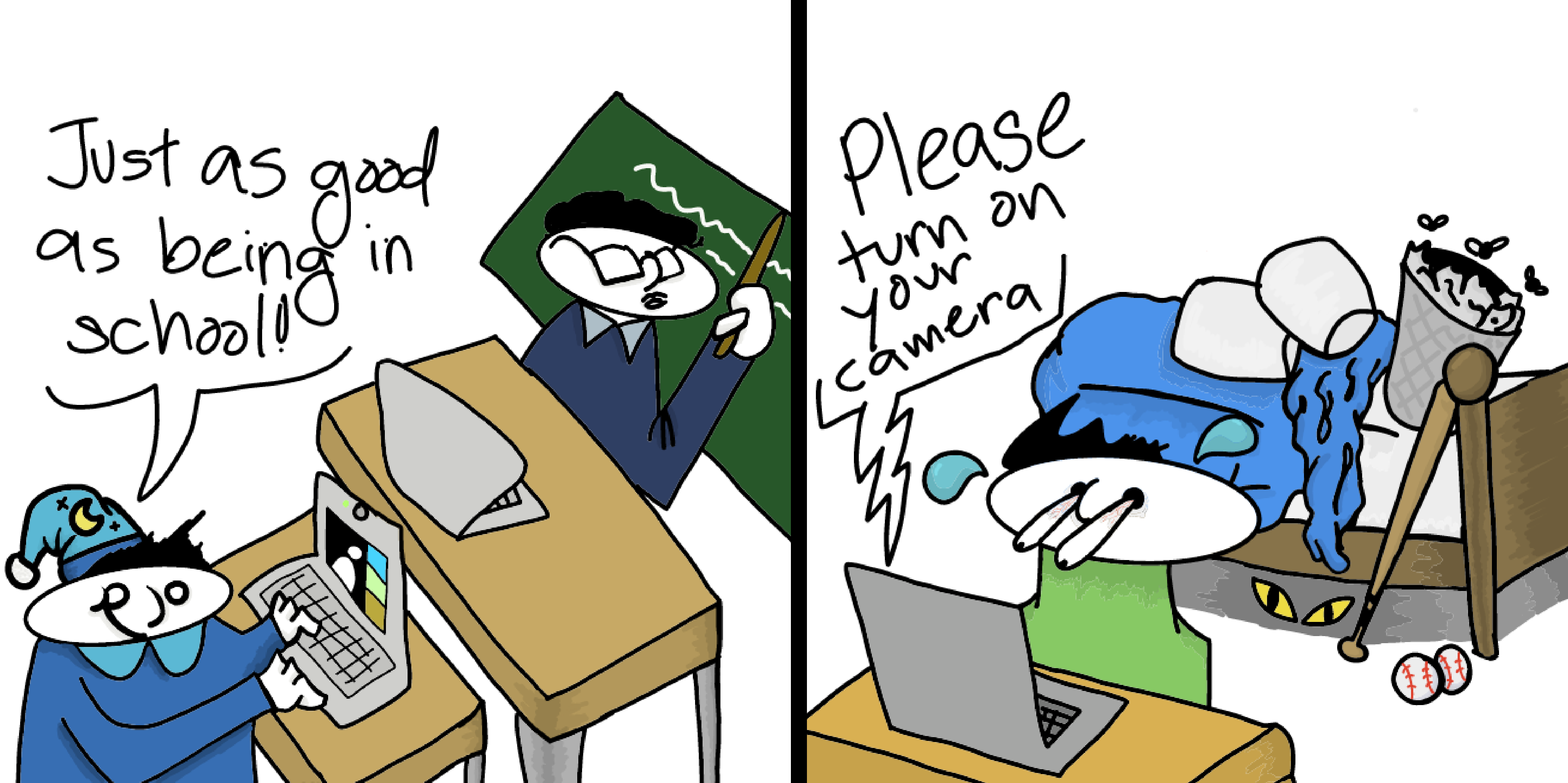
Camera usage in lectures
PRO: Cameras enrich online learning experience
By Andrew Lam
The school’s online format this year has forced classes to change and adapt. However, one key adaptation is missing in some classes: cameras. Having cameras on during class needs to be enforced because, without it, a teacher’s ability to pinpoint their class’ level of confusion and community building among the class is compromised.
Cameras allow teachers to receive valuable feedback in the form of body language from their students. Slight, but noticeable facial expressions can communicate anything from confusion to boredom, which in turn helps the teacher adjust their lecture. This was confirmed by research from Springerplus studying the correlation between facial expression and comprehension recognition. The research concluded that second only to verbal communication, facial expressions are the next most important source of interpreting comprehension in students. Without cameras, teachers lose this valuable tool and students may be left confused. Frequently lagging behind on lessons leads to academic loss, losses that can have a long-term effect especially if the missed lesson is covering a fundamental topic.
An important piece of creating a successful learning environment is building a community. Without cameras, community building is hindered since it is much harder to connect with a box on a screen in place of an expressive human face. When the classroom lacks community, students may feel disconnected from the class, which exacerbates feelings of discomfort. Eventually, this can bleed into actual instruction when students do not feel comfortable enough asking questions during class.
Without cameras on, students may also be more tempted to get distracted. At school, the teacher can see if kids are looking at their phones or doing something other than paying attention. Without cameras, just like with facial expressions, that important information is lost. Eventually, the student will miss important parts of the lesson and set themselves up for failure, something that could easily be prevented by having cameras on.
A reason some students give for not turning on their cameras is that they feel uncomfortable with it, especially if they are the only ones in the class with it on. Being singled out can understandably make someone embarrassed, but the lost quality in learning is too great a cost. All of the lost visual information that allows teachers to see confusion, classrooms to build community, and students to not be distracted should not be lost just because of embarrassment. Cameras need to be on so issues such as feeling singled out are solved and the communication between teachers and students can be enriched.
CON: Camera usage should not be enforced
By Ken Yu
In the shift towards an online learning environment, students are encouraged to turn on their cameras during instruction for a multitude of reasons. However, teachers should not be mandating that a student turn on their camera because it is not the best approach towards creating a comfortable instructional environment for a student. Requiring a student to turn on their camera is a source of discomfort that can harm the student’s ability to learn and their feeling of privacy.
Attending school from home is a drastic change for many students due to the sudden blending of what was once two distinctly separate environments: school and home. As a result, having a student’s video on during instruction allows other students to peek into a fraction of their classmate’s homes, which can be uncomfortable for some. In addition, students have different living circumstances and some cannot find a space within their household that can serve as a suitable environment to engage in distance learning, which can heighten the stress already felt in this new and jarring environment.
In conjunction with the discomfort is the fact that students are unable to tell who and how many people are ‘staring’ at them. On Zoom, there is a feature that puts speaking participants on the spotlight. In an instructional environment where a student’s camera is mandated to be turned on, this feature worsens the anxiety a student may feel when they are called on to answer a question in class where their face is displayed for everyone else to see. In a traditional classroom setting, this would be equivalent to asking a student to answer a question standing at the front of class, which is certainly not an orthodox nor an empathetic method of checking participation.
Although a visual aspect is indeed important to a learning environment in allowing teachers to pick up on body language that helps the teacher adjust and ensure understanding, it should be noted that this is not a perfect reproduction of how it would be in a traditional classroom setting. Depending on a student’s video for visual feedback may not always end well due to technological hiccups and several overlapping circumstances like a bad camera angle. This can result in misunderstandings on the teacher’s end and can impede instructional time and the class itself.
The issue of student camera usage should be approached with a flexible mindset, leaving it to a case by case basis that entirely depends on the teacher themselves. Students should always have the option to use Zoom’s chat feature to participate or respond solely through audio. Camera usage must be encouraged rather than demanded, and while it is integral for there to be visual feedback, it should be in moderation with occasional breaks to allow students to rest their eyes and mind.